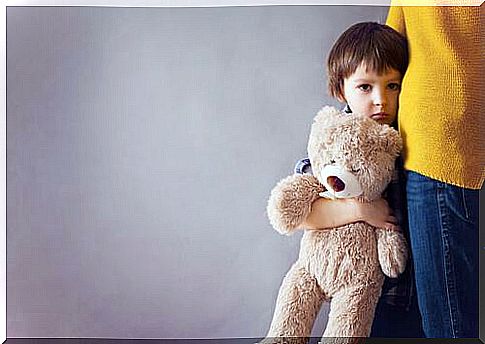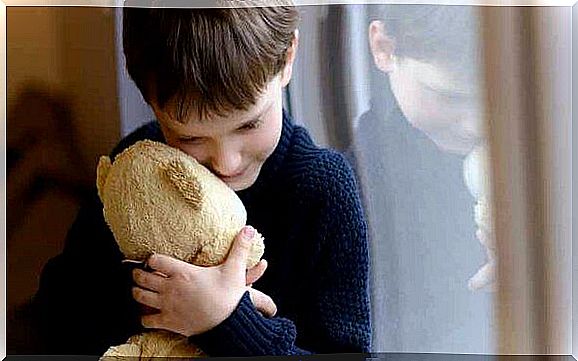Separation Anxiety – When Is It A Problem?

Separation anxiety is a situation we generally associate with children, but many adults experience it as well. It is defined as feeling excessive anxiety when separated from one’s home or from people with whom one has a strong emotional attachment. This includes, for example, parents, grandparents, siblings, children, etc.
The symptoms can range from mild to very severe and are very similar, whether it is children or adults. In adults, it is usually considered a problem that the person has grown up with. But this is not always the case. It can occur at any time during one’s life.
It manifests itself as fear of separating from one’s partner, children, workplace or something that has a lot of sentimental value. It can be very tiring for the person suffering from it, but also for “objects”. Often, it reflects or reinforces an addiction that already existed, to some degree.
The concept of time is not easy and takes years to develop. For many children, any separation is difficult and provokes ailments and tears. Plus, if it is not managed properly by the parents, it can have serious consequences, such as insecurity right into adolescence. It can even pass to other phases of life.
Separation anxiety in childhood
As with all anxiety disorders in childhood or adulthood, it is very important to seek treatment for separation anxiety. Only in rare cases does it disappear by itself.
Usually, it even tends to increase, and can branch out into other areas of life and contribute to the development of other forms of anxiety. These include agoraphobia or panic disorder.

The recommended treatment is usually psychotherapy. However, when it comes to children, the information you gather and some tools that we present to you in this article, for example, could help you prevent this situation. We help you see the warning signs if separation anxiety is in its infancy.
It is a common phase
Certain levels of anxiety over separation are quite normal in certain stages of a child’s development. Between 8 and 14 months, babies who previously had no sense of danger begin to fear strangers or new places. This “normal phase” is a natural adaptation method that helps children adapt and dominate their surroundings.
Usually, this separation anxiety subsides significantly or disappears completely around the age of 2 years. Children at this age understand that their parents can walk away and that they will always come back again later. At the same time, they understand that they can go and come back. With the discovery of this security, they find the courage to explore the world.
This does not mean that children during special or new moments or situations cannot experience a certain degree of anxiety. This anxiety is more likely when they are separated from their parents for a long time if, for example, they have to be hospitalized, change of school, etc.
Separation anxiety tends to provoke many emotions
In this situation, parents can experience many emotions. A feeling of joy may arise because of the attachment that the child has created to them. It can also generate feelings of guilt due to having to leave the child with strangers. It is also normal to feel exhausted or overwhelmed by the amount of attention and time the child requires.
The fact that your child does not want you to go is a good sign of a healthy attachment. This is of course true as long as this desire does not allow for anxiety. A healthy attachment means that there is trust.
Your child has confidence that you will come back when you go your way and that is enough to keep them calm while you are away. A pathological attachment occurs when the child needs confirmation and security all the time and when the child does not have the tools to confront new situations. Thus, these situations are particularly difficult for them.
This is a difficult stage. However, the anxiety should go away as time goes on and with a lot of patience and strength.
On the other hand, if you run into the room every time your child starts crying or you cancel all your plans for the child, it is likely that they will find out using these skills to get you to stay with them. They become aware that they have the power to avoid this separation, which they fear so much.

Plan ahead and try your hand – two important concepts
If you are planning to take your child into day care, then you are likely to experience this separation anxiety that we are referring to. Children are particularly sensitive between 8 months and 1 year of age.
If you have no other choice, then you can practice separation slowly, by taking the child to new places or leaving him with family or caregiver for short periods. Do this gradually more and more until the time comes to leave them in day care.
Save these “repetitions” at times when your child is not tired, restless or hungry. Plan to do so after the child has eaten or taken his nap. Remember that he is only a child and it is much better to introduce changes when one’s basic needs are met.
I prepare for the start-up in day care by visiting it together before the first day. Plus, if possible, make the adjustment gradually. So first the baby will only be alone for a few hours and then you can slowly start increasing the amount of time you are absent.
Coherence, calm, and keeping promises – 3 basic guidelines
If you take your child to a particular daycare, it is because you trust the educators who work there. In this sense, you are trying to be consistent with this decision. Let them help you work on the separation by following their advice.
Remember that they have a lot of experience in dealing with this type of problem, and then of course they want the best for you and your child.
Stay calm and try to transfer this calm and confidence to your child. Explain to them when you want to be back using concepts they can understand. For example, “after lunch”, “after noon”, etc.
You can start a farewell ritual where “goodbye” will be a warm, pleasant and loving event, a moment where you dedicate your full attention to the child. But when you go and do not come back to the time you promised. It could only make things worse.
Stay calm and try to transfer this calm and confidence to your child. Explain to him that you’re coming back.

Win your child’s trust
Make sure you are back to the promised time. In this way, you will build the trust your child has in you and will help them to better understand the situation. Be on time, especially during the customization process.
Although children do not have a very clear sense of time, they will notice how the other children are picked up by their parents, and this may make them worried because you have not come yet.
When it comes time to say goodbye, do not rush out the door even if you see that the child is okay. This could make them feel abandoned. Only leave your child after saying a proper goodbye.
But also do not prolong the procedure of saying goodbye. This method strengthens the feeling that day care can be a bad place or that what is happening is cross-border.
It is not common for separation anxiety to continue every day or for long periods. If you are concerned that your child is not adjusting to being somewhere without you, contact an expert. Keep in mind that you could also strengthen this situation inappropriately. You can also get help from a specialist.









